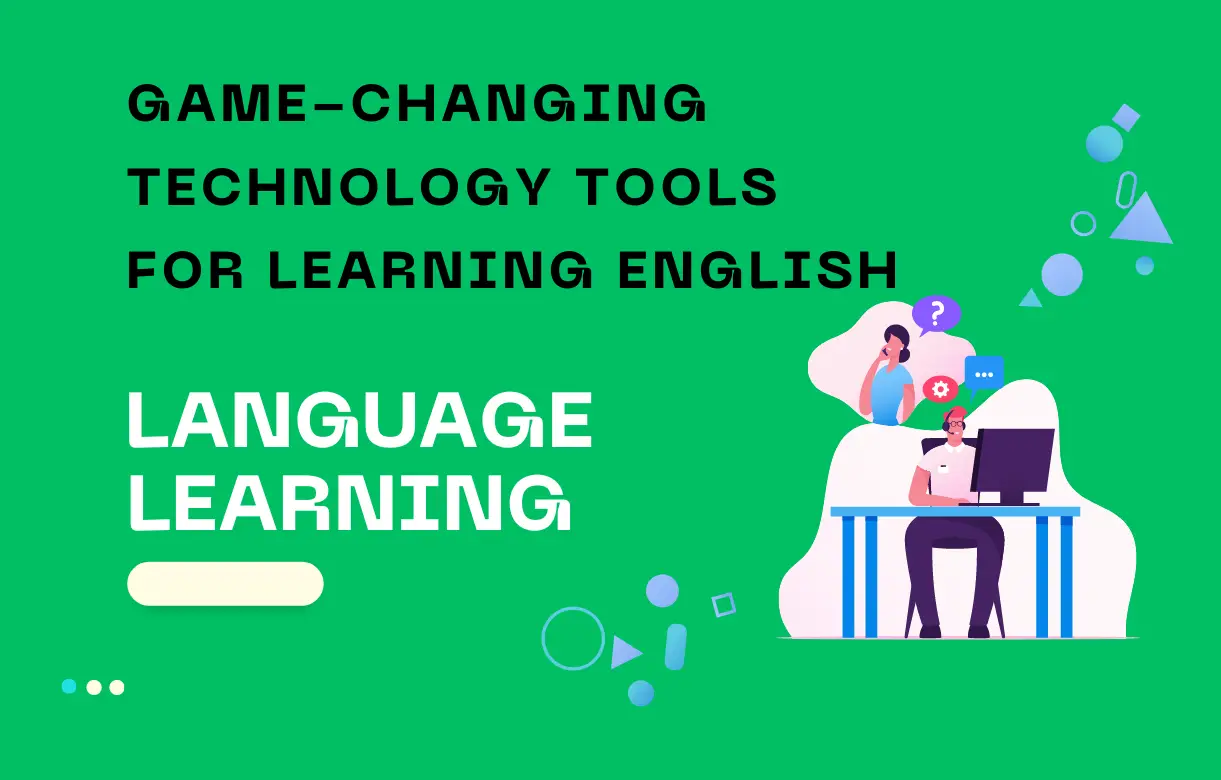Looking to improve your English language skills? Modern technology offers a wealth of tools and resources that can help you achieve your language learning goals. In this comprehensive guide, we’ll explore the benefits of using technology for language learning, highlight some of the best technology tools available, and provide tips and strategies for using technology effectively to improve your English skills.
Whether you’re a beginner or an advanced learner, this guide has something for everyone.
I. Introduction
- Explanation of the importance of learning English
- Overview of how technology can be used for language learning
II. Benefits of using modern technology for language learning
- Convenience and flexibility: One of the main benefits of using modern technology for language learning is the convenience and flexibility it offers. Learners can access language learning materials and tools from anywhere, at any time, making it easier to fit language learning into their busy schedules. Many technology tools also offer self-paced learning options, so learners can work at their own pace and focus on areas that need improvement.
- Interactive and engaging learning experiences: Many technology tools for language learning offer interactive and engaging learning experiences that can help learners stay motivated and engaged with the language. For example, language learning apps might include interactive games, quizzes, and flashcards, while online courses might include videos, interactive exercises, and virtual language exchanges.
- Personalized learning: Modern technology tools can also help learners receive personalized feedback and support, which can be particularly helpful for learners who may not have access to in-person language instruction. Language learning apps and platforms might offer features that analyze learners’ performance and provide customized feedback and recommendations for improvement.
- Access to authentic language resources: Technology tools can also provide learners with access to authentic language resources, such as TV shows, movies, music, and news articles. By accessing authentic language resources, learners can improve their listening, comprehension, and vocabulary skills, and gain a deeper understanding of the language and culture.
- Improved language skills: Ultimately, the use of modern technology in language learning can lead to improved language skills. By providing opportunities for practice, feedback, and immersion, technology tools can help learners build vocabulary, improve pronunciation and grammar, and develop their speaking, listening, reading, and writing skills.
Overall, the use of modern technology in language learning can offer numerous benefits, including convenience and flexibility, interactive and engaging learning experiences, personalized learning, access to authentic language resources, and improved language skills.
By leveraging technology tools in combination with other language learning strategies, learners can create a well-rounded approach to language learning that is tailored to their individual needs and preferences.
III. Technology tools for English language learning
- Online courses: There are many online platforms that offer courses specifically for English language learning. These courses are typically self-paced and offer a range of learning materials, including videos, audio, and interactive exercises. Some popular online course platforms include Duolingo, Rosetta Stone, and Babbel.
- Language exchange apps: These apps connect language learners from around the world to practice speaking with one another. This type of technology is particularly useful for practicing conversational English. Examples of popular language exchange apps include HelloTalk, Tandem, and iTalki.
- Digital flashcard tools: Flashcards are a great way to build vocabulary, and digital flashcard tools can make the process more efficient and fun. Apps such as Anki, Quizlet, and Memrise allow learners to create and study vocabulary flashcards on their computer or mobile device.
- Language learning games: Games can be a fun and engaging way to learn English. Many language learning games are designed to be both educational and entertaining, and can help learners improve their grammar, vocabulary, and pronunciation. Popular English language learning games include The Game of English, English Attack, and Kahoot.
- Language learning podcasts: Listening to English language podcasts is a great way to improve listening comprehension and learn new vocabulary. Some popular English language learning podcasts include ESLPod, British Council LearnEnglish, and All Ears English.
- Language learning YouTube channels: There are many YouTube channels that offer English language instruction, including channels specifically designed for language learners. Examples of popular English language learning YouTube channels include EngVid, Learn English with Emma, and Speak English with Vanessa.
- Language learning apps: There are many mobile apps that offer English language instruction and practice. Some popular language learning apps include Busuu, Babbel, and Lingoda.
By using a combination of these technology tools, learners can create a well-rounded approach to English language learning that incorporates various aspects of the language.
For example, learners can use online courses and language exchange apps to practice grammar and conversation, flashcard tools to build vocabulary, language learning games, and podcasts to improve listening and speaking skills, and YouTube channels and apps to access a wide range of English language materials.
IV. Strategies for using technology effectively in language learning
- Setting goals and using technology tools to track progress: One of the most effective strategies for using technology in language learning is to set goals and track progress using technology tools.
Many language learning apps and platforms offer features that allow learners to set goals, track progress, and receive feedback on their performance. By setting goals and tracking progress, learners can stay motivated and ensure that they are making steady progress towards their language learning objectives. - Finding a balance between technology and in-person language instruction: While technology can be an effective tool for language learning, it’s important to find a balance between technology and in-person language instruction. In-person instruction can provide learners with personalized feedback and support and can be particularly useful for improving pronunciation and conversational skills. To find a balance, learners might consider using technology tools to supplement their in-person instruction, or using technology to prepare for in-person language exchanges or tutoring sessions.
- Using technology to immerse oneself in English language media: One of the most effective ways to improve language skills is through immersion in the language. Technology tools can be particularly useful for creating an immersive language learning environment. For example, learners might watch English language TV shows or movies, listen to English language music or podcasts, or read English language books or articles using technology tools such as streaming services or e-readers.
- Identifying and using technology tools that work best for individual learning styles: Different learners have different learning styles, and it’s important to identify and use technology tools that work best for individual learning styles. For example, visual learners might benefit from using flashcard tools or online courses that include visual elements, while auditory learners might benefit from using language learning podcasts or language exchange apps that provide opportunities for speaking and listening practice.
Overall, the key to using technology effectively in language learning is to find a balance between technology and in-person instruction, set goals and track progress using technology tools, immerse oneself in the language using technology tools, and identify and use technology tools that work best for individual learning styles.
By using technology tools in combination with other language learning strategies, learners can create a well-rounded approach to language learning that incorporates various aspects of the language and provides opportunities for practice and feedback.
V. Tips for staying motivated and accountable when using technology to learn English
Tips for staying motivated and accountable when using technology to learn English
- Set realistic goals: One of the most important ways to stay motivated and accountable when using technology to learn English is to set realistic, achievable goals. Setting goals can help you stay focused on what you want to achieve and give you a sense of accomplishment as you make progress.
- Use a language learning app: Language learning apps can be a great way to stay motivated and accountable when learning English. Many apps offer features like streaks, badges, and leaderboards that can help you track your progress and stay motivated. Some apps also offer daily reminders and notifications to keep you on track.
- Find a language learning partner: Finding a language learning partner can help you stay motivated and accountable by providing a sense of community and support. You can practice your English skills with your partner and motivate each other to stay on track with your language learning goals.
- Join an online language learning community: Joining an online language learning community can be a great way to stay motivated and accountable. You can connect with other learners from around the world, practice your English skills, and get feedback and support from other members of the community.
- Track your progress: Keeping track of your progress can be a great way to stay motivated and accountable when using technology to learn English. You can track your progress using a language learning app, a journal, or a spreadsheet, and celebrate your accomplishments as you reach your goals.
- Stay organized: Staying organized can also help you stay motivated and accountable when learning English. You can use tools like calendars, to-do lists, and task managers to keep track of your language learning tasks and stay on top of your goals.
- Take breaks: Finally, it’s important to take breaks and avoid burnout when using technology to learn English. Taking breaks can help you stay motivated and avoid fatigue, and can actually improve your learning and retention of new information.
By following these tips, you can stay motivated and accountable when using technology to learn English. Remember to set realistic goals, use language learning apps, find a language learning partner, join an online community, track your progress, stay organized, and take breaks as needed. With the right tools and strategies, you can achieve your language learning goals and improve your English skills.
VI. Conclusion
In conclusion, technology has revolutionized the way we learn and communicate, and English language learning is no exception. In this comprehensive guide, we have explored the benefits of using modern technology for language learning, highlighted some of the best technology tools available, and provided tips and strategies for using technology effectively to improve your English skills.
From language learning apps and online resources to social media and communication tools, there are many ways to use technology to enhance your English language learning experience. By setting realistic goals, staying motivated and accountable, and using the right tools and strategies, you can achieve your language learning goals and improve your English skills.
Remember, language learning is a lifelong journey, and the key to success is consistency, persistence, and a willingness to learn and grow. Whether you are a beginner or an advanced learner, technology can help you take your English language skills to the next level.
So, what are you waiting for? Start exploring the world of English language learning technology today!



